Though it may not seem like it now, there was once a time when not every game released in the arcades got a home port. Due to the limitations of consoles, many coin-ops were simply too powerful to be ported, and were left to fade into time. This is true for every generation, including this one (though today it’s more a question of money and willingness than hardware capabilities).
The Genesis era saw a slew of arcade machines that everyone thought were sure to be released either on the console itself, or one of its add-ons. Sadly, Sega never saw fit to indulge their fan base, and those few we did get were radically altered (Shadow Dancer, Moonwalker, ESWAT). Thus, it is with a heavy heart that Sega-16 looks at those poor coin-ops that remain lost in the arcade.
Bear in mind, that this list does not seek to cover any particular category of unreleased games. Our goal here is to identify those titles that seemed like a shoe-in for a home release and didn’t get it, and those that were deserving but simply not considered.
A.B. Cop
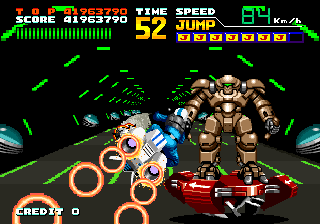 Released on the same board as Afterburner I & II, Super Monaco GP, and Thunder Blade, A. B. Cop (which stands for Air Bike) would perhaps be the one game on this list that did not have a license, more powerful arcade hardware, or funny controls going against it. The scaling is quite similar to that of Afterburner II & Space Harrier II, so the Genesis was quite capable of handling a port. Even the gameplay was simplistic. You simply pilot a hover bike into enemies, blowing them up, and must take out the gang leader boss before the time expires. Jump to avoid gunfire and obstacles. Not the most complicated set up to be sure, but it’s really quite fun.
Released on the same board as Afterburner I & II, Super Monaco GP, and Thunder Blade, A. B. Cop (which stands for Air Bike) would perhaps be the one game on this list that did not have a license, more powerful arcade hardware, or funny controls going against it. The scaling is quite similar to that of Afterburner II & Space Harrier II, so the Genesis was quite capable of handling a port. Even the gameplay was simplistic. You simply pilot a hover bike into enemies, blowing them up, and must take out the gang leader boss before the time expires. Jump to avoid gunfire and obstacles. Not the most complicated set up to be sure, but it’s really quite fun.
So why was there never a port? The most likely reason would be that A. B. Cop didn’t set arcades ablaze in sales, so Sega decided to put their limited resources to porting more profitable and better-known properties, like those mentioned above. It’s unfortunate, as A. B. Cop would have been a blast on the Genesis.
Arabian Fight
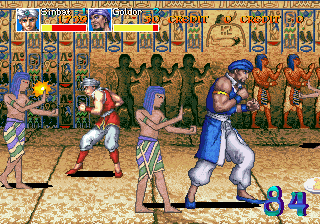 Oh, did this one have me excited. I remember seeing it previewed in an old issue of Mega Play Magazine, and it seemed like such a sure thing for a Sega CD release. Beat-’em-ups were still pretty huge at the time, and I’m sure that most gamers of the time would have overlooked Arabian Fight‘s repetitive gameplay and stiff animation. There’s scaling and rotation all over the place, and it’s still cool how thugs would jump into the screen from the foreground, looking around before leaping. The four playable characters zoom in and out as they fight around the screen, and even their magic attacks make use of the scaling feature. Pick up a magic lamp and press both buttons to make the character leap into the foreground and do a series of maneuvers that eliminates everything onscreen. Very, very nice to look at. Since Arabian Fight ran on Sega’s System 32 hardware (the same used for Revenge of Death Adder), some sacrifices would have to have been made for it to come home. I’m sure that if Sega had taken the time, it could have been done. It most certainly wouldn’t have had any problems as a 32X-CD game, and would have done wonders for pushing the sales of both add-ons.
Oh, did this one have me excited. I remember seeing it previewed in an old issue of Mega Play Magazine, and it seemed like such a sure thing for a Sega CD release. Beat-’em-ups were still pretty huge at the time, and I’m sure that most gamers of the time would have overlooked Arabian Fight‘s repetitive gameplay and stiff animation. There’s scaling and rotation all over the place, and it’s still cool how thugs would jump into the screen from the foreground, looking around before leaping. The four playable characters zoom in and out as they fight around the screen, and even their magic attacks make use of the scaling feature. Pick up a magic lamp and press both buttons to make the character leap into the foreground and do a series of maneuvers that eliminates everything onscreen. Very, very nice to look at. Since Arabian Fight ran on Sega’s System 32 hardware (the same used for Revenge of Death Adder), some sacrifices would have to have been made for it to come home. I’m sure that if Sega had taken the time, it could have been done. It most certainly wouldn’t have had any problems as a 32X-CD game, and would have done wonders for pushing the sales of both add-ons.
Aurail
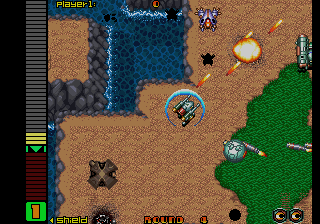 In 1992 it seemed that there wasn’t a shmup that wasn’t on the Genesis, and while Aurail isn’t exactly a true shmup, it’s close enough to make you wonder why it was never ported. As the pilot of a laser-firing mech, you blast through multiple stages, taking out enemy mechs and tanks, until you reach a temple or building. Once inside, the action switches to a first-person perspective, and you’re tasked with eliminating a certain amount of foes before moving on to the next area.
In 1992 it seemed that there wasn’t a shmup that wasn’t on the Genesis, and while Aurail isn’t exactly a true shmup, it’s close enough to make you wonder why it was never ported. As the pilot of a laser-firing mech, you blast through multiple stages, taking out enemy mechs and tanks, until you reach a temple or building. Once inside, the action switches to a first-person perspective, and you’re tasked with eliminating a certain amount of foes before moving on to the next area.
Decently detailed graphics, lots of power ups, and some solid gameplay make Aurail a winner. Considering that Sega never really released a lot of shmups on the Genesis themselves, one would think that they would have been all over this. The unique combination of perspectives and the cool premise would probably not have suffered much during the transition from the System-16 board to the Genesis.
Borench
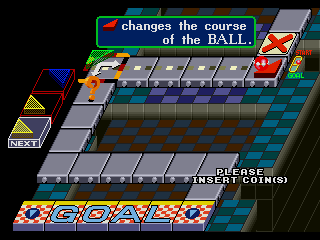 Marble Madness fans should be especially mad about this one. If we got the former, we most certainly deserved the latter. Playing much better on the Genesis and just as much fun, Borench is madly addicting. Your little marble falls in a straight line, and you must guide it around the insanely designed stages, using right angled triangles to make it change direction. The thing is, you never know which direction the next triangle will be facing, since they are given to you in a random Tetris-style format. This means you’ll have to think ahead, and fast, as the marble heads towards a hole or the edge of the plane.
Marble Madness fans should be especially mad about this one. If we got the former, we most certainly deserved the latter. Playing much better on the Genesis and just as much fun, Borench is madly addicting. Your little marble falls in a straight line, and you must guide it around the insanely designed stages, using right angled triangles to make it change direction. The thing is, you never know which direction the next triangle will be facing, since they are given to you in a random Tetris-style format. This means you’ll have to think ahead, and fast, as the marble heads towards a hole or the edge of the plane.
Really, the more I think of it, the angrier I get that such a great game was never brought home. The Genesis could have easily handled Borench, but I suppose it wasn’t high on Sega’s list of priorities. Even so, how big a team would a translation have actually required?
Desert Breaker
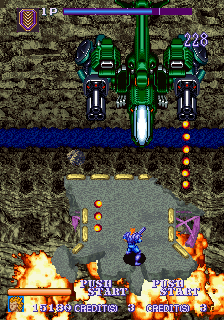 Sega must have really had fun when it ported Capcom’s MERCS to the Genesis, because Desert Breaker boasts most of what made that title so great. Multiple playable characters onscreen at the same time, great weapons, huge playfields, and useable vehicles are all concepts Sega borrowed from Capcom for this one. The thing is, it doesn’t come off as a cheap copy. Desert Breaker plays wonderfully and could easily have been released on the Sega CD, which had a gaping hole in the RnG department at the time (still does, too). The huge explosions and frantic action would have been a big seller, I’m sure, and given Sega’s experience with MERCS, there was simply no reason for this title to be denied a home release. Perhaps Sega were too proud to follow Capcom’s lead? I don’t see why this would be an issue; it never has been for Namco. Desert Bringer would have definitely moved systems, and probably could have been done as a 32X cart too. The System-18 hardware was also home to Alien Storm and Shadow Dancer, both of which found their way to the Genesis. Even if they changed the level layout and sprites, like they did with the aforementioned games, it still would have been at least on the level of MERCS. It’s not as colorful, and the graphics themselves aren’t as sharp as Capcom’s classic, but this is still one hell of a game that would have been welcomed by Genesis owners with open arms. The amount of domestically released top-down RnGs is quite small, so what the hell happened?
Sega must have really had fun when it ported Capcom’s MERCS to the Genesis, because Desert Breaker boasts most of what made that title so great. Multiple playable characters onscreen at the same time, great weapons, huge playfields, and useable vehicles are all concepts Sega borrowed from Capcom for this one. The thing is, it doesn’t come off as a cheap copy. Desert Breaker plays wonderfully and could easily have been released on the Sega CD, which had a gaping hole in the RnG department at the time (still does, too). The huge explosions and frantic action would have been a big seller, I’m sure, and given Sega’s experience with MERCS, there was simply no reason for this title to be denied a home release. Perhaps Sega were too proud to follow Capcom’s lead? I don’t see why this would be an issue; it never has been for Namco. Desert Bringer would have definitely moved systems, and probably could have been done as a 32X cart too. The System-18 hardware was also home to Alien Storm and Shadow Dancer, both of which found their way to the Genesis. Even if they changed the level layout and sprites, like they did with the aforementioned games, it still would have been at least on the level of MERCS. It’s not as colorful, and the graphics themselves aren’t as sharp as Capcom’s classic, but this is still one hell of a game that would have been welcomed by Genesis owners with open arms. The amount of domestically released top-down RnGs is quite small, so what the hell happened?
Golden Axe: Revenge of Death Adder
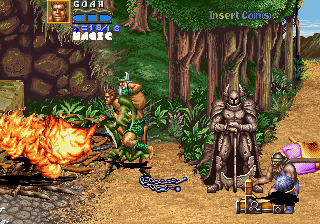 “It’s too powerful for home consoles.” That’s what I heard repeatedly whenever I bitched and moaned that perhaps one of the best arcade games Sega ever released was left to rot in arcades. You can bet I didn’t believe a word of it, given the Sega CD and its under-used and under-appreciated 32X sibling. How the hell could this game be too powerful? System-32 was no slouch in the processor department, and perhaps the game would have to be trimmed down graphically, and the colors would have been severely reduced from the arcade’s 16,384, but I don’t see how the same Sega CD that ran Soul Star would not have been able to handle RoDA. Done right, it most certainly would have turned out better than Out Runners did. Even worse, consoles have advanced well beyond the System 32’s capabilities, and we’re still denied a home release. It must all be part of Sega’s master plan to rape the franchise into oblivion, first with Golden Axe: The Duel on Saturn, and the remake included in the Sega Classics Collection.
“It’s too powerful for home consoles.” That’s what I heard repeatedly whenever I bitched and moaned that perhaps one of the best arcade games Sega ever released was left to rot in arcades. You can bet I didn’t believe a word of it, given the Sega CD and its under-used and under-appreciated 32X sibling. How the hell could this game be too powerful? System-32 was no slouch in the processor department, and perhaps the game would have to be trimmed down graphically, and the colors would have been severely reduced from the arcade’s 16,384, but I don’t see how the same Sega CD that ran Soul Star would not have been able to handle RoDA. Done right, it most certainly would have turned out better than Out Runners did. Even worse, consoles have advanced well beyond the System 32’s capabilities, and we’re still denied a home release. It must all be part of Sega’s master plan to rape the franchise into oblivion, first with Golden Axe: The Duel on Saturn, and the remake included in the Sega Classics Collection.
Laser Ghost
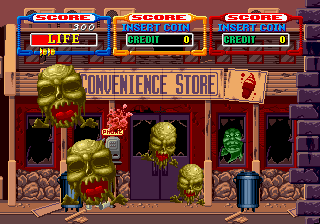 System-18 games never seemed to get a break, eh? Perhaps Laser Ghost should have picketed Sega’s offices, along with Moonwalker & Shadow Dancer. Both those games got altered when they came home, but Laser Ghost got the worst treatment of all. It was turned into a Phaser game for the Master System! Gone were the streets filled with evil phantoms and vile spirits. You now had to guide a young girl around the screen, avoiding ghosts as you go. Not only was the story altered, but the gameplay was as well. In the arcades, Laser Ghost played more like the shooting sequences in Alien Storm, with plenty of exploding action and gooey deaths. Three players could go ghost-busting at once, and this would undoubtedly have been changed for a home release, unless Sega actually decided to support their multi-tap. After 1992, I was looking for any reason to use my Menacer, and this would have been perfect for it. I could really have seen Laser Ghost on the 32X, as the color scheme and graphics look like they could have been done without losing much. Too bad we’ll never know.
System-18 games never seemed to get a break, eh? Perhaps Laser Ghost should have picketed Sega’s offices, along with Moonwalker & Shadow Dancer. Both those games got altered when they came home, but Laser Ghost got the worst treatment of all. It was turned into a Phaser game for the Master System! Gone were the streets filled with evil phantoms and vile spirits. You now had to guide a young girl around the screen, avoiding ghosts as you go. Not only was the story altered, but the gameplay was as well. In the arcades, Laser Ghost played more like the shooting sequences in Alien Storm, with plenty of exploding action and gooey deaths. Three players could go ghost-busting at once, and this would undoubtedly have been changed for a home release, unless Sega actually decided to support their multi-tap. After 1992, I was looking for any reason to use my Menacer, and this would have been perfect for it. I could really have seen Laser Ghost on the 32X, as the color scheme and graphics look like they could have been done without losing much. Too bad we’ll never know.
Power Drift
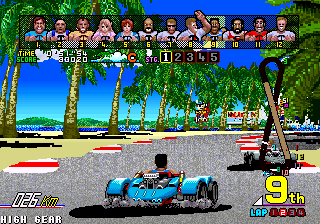 Perhaps more than any game on this list, Power Drift‘s lack of a home translation infuriates me the most. I know it was released on the PC-Engine and several computer formats, but that’s not the point. This was a game that was seemingly made to showcase the Sega CD’s biaxial rotation and scaling. One look at it in motion and you know there was no excuse for not bringing it home, especially when the Sega CD was practically bone dry when it came to racing games. Powered by Y-Board hardware- the same one behind Galaxy Force II- it could have been done on CD with little effort and would most likely have gone a ways towards selling some systems. The PC-Engine version appeared in 1990, so what was the reason for not bringing it to a console that could have done it real justice? We got butchered ports of Galaxy Force II & G Loc (both of which should have been done on the Sega CD), so why not Power Drift? Instead, we got more FMV games. Is it any wonder Sega is no longer a hardware-oriented company?
Perhaps more than any game on this list, Power Drift‘s lack of a home translation infuriates me the most. I know it was released on the PC-Engine and several computer formats, but that’s not the point. This was a game that was seemingly made to showcase the Sega CD’s biaxial rotation and scaling. One look at it in motion and you know there was no excuse for not bringing it home, especially when the Sega CD was practically bone dry when it came to racing games. Powered by Y-Board hardware- the same one behind Galaxy Force II- it could have been done on CD with little effort and would most likely have gone a ways towards selling some systems. The PC-Engine version appeared in 1990, so what was the reason for not bringing it to a console that could have done it real justice? We got butchered ports of Galaxy Force II & G Loc (both of which should have been done on the Sega CD), so why not Power Drift? Instead, we got more FMV games. Is it any wonder Sega is no longer a hardware-oriented company?
Segasonic The Hedgehog
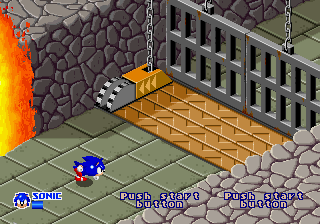 Ok, let me see if I understand this correctly. Sega introduces Sonic The Hedgehog to massive sales, and ends up taking the 16-bit market away from Nintendo because of it. They release an arcade game with their new prize mascot- and don’t bring it home? Granted, the trackball control the machine had could have been a problem initially, but was nothing Mega Mouse support couldn’t have fixed. This could have been a big feather in the 32X’s cap, and would have definitely spurred buyer support for the hardware. The gameplay was simple, the graphics wouldn’t have pushed the 32X too much, and the mere fact that it was a Sonic game would have made people take an interest in it. Sadly, Sega of Japan never had any real intention of supporting SOA’s low cost 32-bit alternative, and Segasonic the Hedgehog remained arcade-only, never to be seen on a home console. So clueless is Sega in regards to it, that it wasn’t even included in either of the Sonic compilations released this generation.
Ok, let me see if I understand this correctly. Sega introduces Sonic The Hedgehog to massive sales, and ends up taking the 16-bit market away from Nintendo because of it. They release an arcade game with their new prize mascot- and don’t bring it home? Granted, the trackball control the machine had could have been a problem initially, but was nothing Mega Mouse support couldn’t have fixed. This could have been a big feather in the 32X’s cap, and would have definitely spurred buyer support for the hardware. The gameplay was simple, the graphics wouldn’t have pushed the 32X too much, and the mere fact that it was a Sonic game would have made people take an interest in it. Sadly, Sega of Japan never had any real intention of supporting SOA’s low cost 32-bit alternative, and Segasonic the Hedgehog remained arcade-only, never to be seen on a home console. So clueless is Sega in regards to it, that it wasn’t even included in either of the Sonic compilations released this generation.
Spider-Man: The Video Game
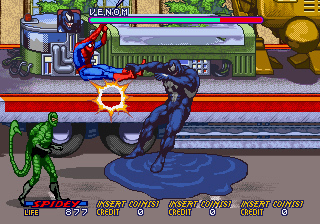 I remember the first time I saw Spider-Man: The Video Game in arcades. Right off the bat, I saw that big, blue Sega logo and thought “this one will be on my Genesis!” As with every other title on this list, I waited in vain for a translation. Could it have been done properly in cart form? Probably not. On the Sega CD? Heck yes. Securing the license for a home port should not have been a problem, as Sega was already licensed to make Spider-Man games. The main reason, just like with Revenge of Death Adder, must have been a simple lack of interest. Even more so than Golden Axe, Spider-Man could have been done on the Sega CD, as the sprites were no larger or more detailed than those in Final Fight CD. Furthermore, if Samurai Showdown could retain its zoom feature, so could Spider-Man. The four-player simultaneous play would have been cut, but that didn’t hinder home ports of other arcade favorites, like TMNT & Captain America & the Avengers. By the time the 32X was released, Sega probably considered Spider-Man to be old hat, and that is unfortunate, especially when one considers the bombardment of older titles they’ve been unleashing for the last decade or so.
I remember the first time I saw Spider-Man: The Video Game in arcades. Right off the bat, I saw that big, blue Sega logo and thought “this one will be on my Genesis!” As with every other title on this list, I waited in vain for a translation. Could it have been done properly in cart form? Probably not. On the Sega CD? Heck yes. Securing the license for a home port should not have been a problem, as Sega was already licensed to make Spider-Man games. The main reason, just like with Revenge of Death Adder, must have been a simple lack of interest. Even more so than Golden Axe, Spider-Man could have been done on the Sega CD, as the sprites were no larger or more detailed than those in Final Fight CD. Furthermore, if Samurai Showdown could retain its zoom feature, so could Spider-Man. The four-player simultaneous play would have been cut, but that didn’t hinder home ports of other arcade favorites, like TMNT & Captain America & the Avengers. By the time the 32X was released, Sega probably considered Spider-Man to be old hat, and that is unfortunate, especially when one considers the bombardment of older titles they’ve been unleashing for the last decade or so.
The sheer amount of Sega arcade titles never brought home is staggering, and this list only represents some of the more deserving titles. In our next installment, we’ll take a look at the third party games that were left behind. I urge you to bring a stress ball to squeeze, as it only gets worse from here.

It truly was one of the biggest tragedies that Golden Axe: The Revenge Of Death Adder was never released on a home console. The Sega CD (which was the most powerful system made by Sega at the time of the game’s arcade debut) could have maybe pulled off a somewhat decent port, even if it still would have been far from arcade perfect at the same time though. Would have been far better than nothing at the very least. But even then, a 32X, if not a Saturn would have been required in order to do the game just about full justice, which (along with the beat up genre in general) was sadly old news by then. Too bad they couldn’t have just included it as an unlockable, and/or a double feature of sorts on Golden Axe: The Duel for the Saturn, which was hardly an inspirational game by any means, and would have been a great sell. But at least it’s finally getting a long awaited official home release via the Arcade 1Up, and am guessing will finally get an actual console version not too long after at last also. At least there’s always been Mame as well, thank goodness.